Confidentiality Policy Template
Effective Date: [Insert Date]
Last Reviewed: [Insert Date]
1. Purpose
This Confidentiality Policy establishes guidelines for protecting sensitive and confidential information belonging to [Company Name], its clients, employees, and business partners. This policy applies to all employees, contractors, consultants, and third parties who have access to confidential information.
2. Scope
This policy applies to all forms of confidential information, whether written, electronic, or verbal, and covers:
Proprietary business information
Financial data and records
Customer and client information
Employee personal data
Trade secrets and intellectual property
Strategic plans and business operations
Technical data and research
Marketing strategies and customer lists
3. Definition of Confidential Information
Confidential information includes, but is not limited to:
Any information marked or identified as "Confidential," "Proprietary," or "Restricted"
Information that a reasonable person would consider confidential given the nature and circumstances
Information disclosed during employment or business relationship that is not publicly available
Information about clients, customers, suppliers, or business partners
Financial information, pricing structures, and profit margins
Business plans, strategies, and forecasts
Personnel information and employment records
4. Responsibilities
4.1 All Personnel Must:
Protect confidential information from unauthorized access, use, or disclosure
Use confidential information only for legitimate business purposes
Follow proper security protocols for handling sensitive data
Report any suspected breaches immediately to [Designated Contact/Department]
Return or destroy all confidential materials upon termination of employment or contract
4.2 Management Must:
Ensure employees understand and comply with this policy
Implement appropriate security measures to protect confidential information
Conduct regular training on confidentiality requirements
Monitor compliance and address violations promptly
5. Permitted Disclosures
Confidential information may be disclosed only when:
Required by law or legal process
Authorized in writing by [Appropriate Authority]
Necessary for legitimate business purposes and disclosed only to authorized individuals
Covered by an appropriate non-disclosure agreement
6. Security Measures
To protect confidential information, personnel must:
Use strong passwords and change them regularly
Lock computers and secure workspaces when unattended
Encrypt sensitive electronic communications
Dispose of confidential documents using secure methods (shredding, secure disposal bins)
Avoid discussing confidential matters in public places
Use secure networks for accessing confidential information remotely
Report lost or stolen devices containing confidential information immediately
7. Third-Party Agreements
Before sharing confidential information with third parties, a written non-disclosure agreement (NDA) must be executed. All third parties must comply with the same confidentiality standards outlined in this policy.
8. Duration of Confidentiality Obligations
Confidentiality obligations continue:
During the course of employment or business relationship
After termination of employment or contract, indefinitely or as specified in employment agreements
Until information becomes publicly available through no fault of the recipient
9. Consequences of Violations
Violations of this policy may result in:
Disciplinary action, up to and including termination of employment
Legal action, including civil or criminal prosecution
Financial liability for damages caused by the breach
Termination of business relationships or contracts
10. Reporting Breaches
Any suspected or actual breach of confidentiality must be reported immediately to:
[Contact Name/Department]
Email: [Email Address]
Phone: [Phone Number]
11. Policy Review
This policy will be reviewed [annually/biannually] and updated as necessary to ensure continued effectiveness and compliance with applicable laws and regulations.
12. Acknowledgment
All employees and contractors must sign an acknowledgment form confirming they have read, understood, and agree to comply with this Confidentiality Policy.
Approved by:
[Name, Title]
[Signature]
[Date]
Employee Acknowledgment Form
I acknowledge that I have received, read, and understood the Confidentiality Policy of [Company Name]. I agree to comply with all provisions of this policy and understand that violations may result in disciplinary action, including termination, and potential legal consequences.
Employee Name: ___________________________
Signature: ___________________________
Date: ___________________________
Department: ___________________________
Confidentiality Policy Template
1.OBJECTIVE
•[Company Name] recognizes that employees, contractors, sub-contractors & others who work within our organization, gain information about individuals and organizations during the course of their work or activities.
•In most cases, such information will not be stated as confidential and individual may have to exercise common sense and discretion in identifying whether information is expected to be confidential.
•This policy aims to give guidance but if in doubt, seek advice from your line manager.
2.SCOPE
This policy is applicable to all employees working at all levels of the organization, as well as other workers, including agency employees, temporary staff, consultants and independent contractors. Third parties who have access to [Company Name]'s premises (such as self-employed contractors, self-employed sub-contractors, customers and visitors) are also required to comply with this policy. Such employees, workers, and third parties are referred to herein collectively as the "Covered Parties".
3.GENERAL GUIDELINES
•Information received by [Company Name] as part of the services it provides, will be considered as the information for [Company Name] to share and use, to fulfil its aims and objectives.
•Covered Party should inform groups, organizations or individuals why they are requesting information and explain the purpose of storing and using this information.
•Covered Party should seek permission to keep and use this information.
•Covered Parties are allowed to share information with their Line Managers in order to discuss issues and seek advice.
•Covered Parties will not disclose to anyone, other than their line managers, any information considered sensitive, personal, financial or private without the knowledge or consent of the individual, or an officer, in the case of an organization.
•Covered Parties should avoid exchanging personal information or comments (gossip) about individuals with whom they have a professional relationship.
•Covered Parties should avoid talking about organizations or individuals in social settings.
•There may be circumstance where covered parties would want to discuss difficult situations with each other to gain a wider perspective on how to approach a problem.
•If covered parties receive information from individuals outside [Company Name] regarding the conduct of a covered party or group, then this should be dealt with efficiently and sensitively. The appropriate covered party should tell the individual about the complaint procedure and advise them accordingly.
•If employees are dissatisfied with the conduct of a covered party, and have sensitive information that could be evidenced through investigation, they should discuss it with the appropriate line manager under the Whistle Blowing Procedure. Any allegation, which is found to be malicious, or ill-founded, will be dealt with by [Company Name] under the Grievance Redressal and Disciplinary Action Policy.
•Where there is a legal duty/obligation on [Company Name] to disclose information, the person that is affected will be informed that the disclosure has or will be made.
4.WHY CONFIDENTIALITY
•Most information held by [Company Name] relates to Individuals or service users, members, employees, trustees, and volunteers.
•Information is kept to enable [Company Name] covered parties to understand the needs of individuals or service users in order to deliver the most appropriate services and products.
•Information about users may be kept for the purpose of monitoring and reporting.
5.ACCESS TO INFORMATION
•Information is confidential to [Company Name] as an organization and may be shared with the covered party, line managers or trustees to ensure best quality services & products for users.
•Where information is sensitive, i.e. it involves disputes or legal issues, it will be confidential to the employee dealing with the case and their line manager. Such information should be clearly labelled 'Confidential' and should state the names of the covered parties entitled to access the information and the name of the individual or group who may request access to the information.
•Covered parties will not withhold information from their line manager unless it is purely personal to them and not business related.
•Users may see [Company Name] records which relates to them or their organization. The request must be made in writing with the Line Manager & HR Head giving 14 days' notice. The letter must be signed by the individual, or in the case of an organization’s records, by the Chief Executive Officer.
•Sensitive information as outlined above will only be made available to the person or organization named on the file.
•Employees may see all of their personnel records by giving 14 days' notice in writing to the line manager.
•When photocopying or working on confidential documents, covered parties must ensure they are not seen by the people passing by. This also applies to information on computer screens.
6.STORING INFORMATION
•General non-confidential information about the organization is kept in unlocked filing cabinets that are available to all the company’s covered parties.
•Information about volunteers, interns and other individual’s will kept in filing cabinets by the covered party directly responsible. Covered parties must ensure that their line managers know how to gain access.
•Employees' personnel information will be kept in lockable filing cabinets under the custody of line managers/business HR and will be accessible to the Senior Management.
•Files or filing cabinet drawers bearing confidential information should be labelled 'confidential'.
•In an emergency situation, the senior management may authorize access to files by other people.
•Ensure confidential documentation or personal data is shredded before putting in the recycling bins.
7.DISCLOSURE OF INFORMATION
[Company Name] has a legal duty to disclose some information including:
•Any criminal or unlawful act will be disclosed to the police.
•In addition, covered pc1rty believing an illegal act has taken place, or that a user is at risk of harming themselves or others, must report Ill to the line manager/ business HR who will report it to the appropriate authorities.
•[Company Name] should inform the users of this disclosure.
8.DATA PROTECTION
Information about individuals, whether on computer or on paper, must comply with the data protection principles, which states that the personal data must be:
•Obtained and processed fairly and lawfully
•Held only for specified purposes
•Adequate, relevant and not excessive
•Accurate and up to date
•Kept no longer than necessary
•Securely kept and protected
9.BREACH OF CONFIDENTIALITY
•Covered parties who are dissatisfied with the conduct or actions of other covered parties or [Company Name] should raise this with their line manager/ business HR using the grievance procedure, if necessary, and should not discuss their dissatisfaction outside [Company Name].
•Covered parties accessing unauthorized files or breaching confidentially may face disciplinary action. Ex-employees breaching confidentiality may face legal action.
•Any covered parties who have concerns about the use of [Company Name] funds, or any practice by any employee must comply with the requirements of the Whistle Blowing Policy.
10.DISCLAIMER
•The policy and procedures explained in this document may change at any time, at the sole discretion of the Management of [Company Name], without prior notice. No statement or promise by a supervisor, manager or department head may be interpreted as a change in policy nor will it constitute an agreement with an employee.
•This policy document should be read in conjunction with Local Labor laws which for the avoidance of doubt will take precedence over this policy document
•This policy document shall be effective from the date of issuance and supersede all previous procedures and understandings pertaining to the subject.
Employee Confidentiality Agreement Letter
Subject: Confidentiality Agreement
Dear [Employee Name],
As part of your employment with [Company Name], you will have access to confidential and proprietary information that is critical to our business operations. This letter serves as a formal confidentiality agreement between you and [Company Name].
You agree to maintain the strictest confidence regarding all proprietary information, including but not limited to: trade secrets, client lists, financial data, marketing strategies, product development plans, and any other information marked as confidential or that would reasonably be considered confidential.
This obligation extends throughout your employment and continues indefinitely after your departure from the company. You agree not to disclose, copy, or use any confidential information for personal gain or for the benefit of any third party without express written authorization.
Violation of this agreement may result in immediate termination and legal action, including claims for damages and injunctive relief.
Please sign and return a copy of this letter to acknowledge your understanding and acceptance of these terms.
Sincerely,
[Your Name]
[Your Title]
[Company Name]
Employee Acknowledgment:
I, [Employee Name], have read and agree to the terms outlined above.
Signature: _________________ Date: _________
Vendor/Contractor Confidentiality Agreement Message
Subject: Confidentiality Agreement for Services Engagement
Dear [Vendor/Contractor Name],
Thank you for partnering with [Company Name] on [Project Name]. Before we proceed, we require all external vendors and contractors to sign a confidentiality agreement to protect our proprietary business information.
During the course of this engagement, you may be exposed to confidential information including technical specifications, business processes, customer data, pricing structures, and strategic plans. You agree to:
1. Use confidential information solely for the purpose of fulfilling your contractual obligations
2. Implement reasonable security measures to protect all shared information
3. Limit access to confidential information to only those team members who require it
4. Return or destroy all confidential materials upon completion of the project
5. Refrain from disclosing any confidential information to third parties without prior written consent
This agreement remains in effect for [Duration] following the completion of our business relationship. Any breach of confidentiality may result in termination of the contract and potential legal consequences.
Please review, sign, and return the attached formal agreement within [Number] business days.
Best regards,
[Your Name]
[Your Title]
[Company Name]
Confidentiality Breach Notification Letter
Subject: URGENT - Confidentiality Breach Notice
Dear [Recipient Name],
I am writing to inform you of a serious matter that requires your immediate attention. It has come to our knowledge that confidential information belonging to [Company Name] may have been disclosed without authorization on [Date].
The breach involves: [Brief description of what information was compromised]
This incident is in direct violation of the confidentiality agreement you signed on [Date]. We take the protection of our proprietary information extremely seriously, and this breach has potentially caused significant harm to our business operations and competitive position.
We are conducting a thorough investigation into this matter and request your full cooperation. Please provide a written explanation of the circumstances surrounding this incident within [Number] business days of receiving this letter.
Depending on the outcome of our investigation, we may pursue all available legal remedies, including termination of employment/contract, monetary damages, and injunctive relief.
Please contact [Contact Person] at [Contact Information] to discuss this matter further.
Sincerely,
[Your Name]
[Your Title]
[Company Name]
Mutual Confidentiality Agreement Email (Business Partnership)
Subject: Mutual Non-Disclosure Agreement for Partnership Discussion
Hi [Recipient Name],
I'm excited about the possibility of [Company A] and [Company B] exploring a potential partnership. Before we dive into detailed discussions, I'd like to propose a mutual confidentiality agreement to protect both our interests.
As we share information about our respective operations, technologies, and strategic plans, it's important that we both feel secure that this information won't be misused or disclosed to competitors.
The key terms I'm proposing:
- Both parties agree to keep all shared information confidential
- Information can only be used to evaluate the potential partnership
- The agreement covers information shared verbally, in writing, or electronically
- Obligations continue for [Duration] after our discussions conclude
- Either party can request the return or destruction of shared materials at any time
I've attached a standard mutual NDA for your review. If your legal team has any modifications or if you'd prefer to use your own template, I'm happy to work with that.
Looking forward to a productive conversation once we have this in place!
Best,
[Your Name]
[Your Title]
[Company Name]
Confidentiality Reminder Email to Team Members
Subject: Important Reminder: Confidentiality Obligations
Dear Team,
As we move forward with [Project Name/Initiative], I want to take a moment to remind everyone of our confidentiality obligations. The information we're working with is highly sensitive and could significantly impact our competitive position if disclosed.
Please remember:
- Do not discuss project details in public places (elevators, cafes, public transportation)
- Ensure all confidential documents are properly secured when not in use
- Use only company-approved channels for sharing sensitive information
- Be mindful of who can see your screen when working remotely or in shared spaces
- Never share login credentials or access confidential systems from unsecured networks
- If you're unsure whether something is confidential, assume it is and ask before sharing
These aren't just company policies—they're legal obligations that each of us accepted when we joined the team. Protecting our confidential information protects our jobs, our company's future, and our competitive advantage.
If you have any questions about what information is considered confidential or how to handle specific situations, please don't hesitate to reach out to me or [Contact Person] in [Department].
Thank you for your continued diligence and professionalism.
[Your Name]
[Your Title]
Confidentiality Agreement Termination Letter
Subject: Termination of Confidentiality Agreement
Dear [Recipient Name],
This letter serves as formal notification that the Confidentiality Agreement dated [Original Agreement Date] between [Party A] and [Party B] will be terminated effective [Termination Date].
While the active period of our agreement is concluding, please note that certain obligations continue beyond this termination date:
- All information designated as confidential during the agreement period remains protected
- You are required to return or destroy all confidential materials within [Number] days
- The non-disclosure obligations continue for [Duration] as specified in the original agreement
- Any previously granted permissions or licenses to use confidential information are hereby revoked
Please provide written confirmation that all confidential materials have been returned or destroyed, and that you have taken appropriate steps to ensure no copies remain in your possession or control.
We appreciate your adherence to the confidentiality terms throughout our business relationship and trust that you will continue to honor your post-termination obligations.
If you have any questions regarding your ongoing obligations, please contact our legal department at [Contact Information].
Sincerely,
[Your Name]
[Your Title]
[Company Name]
Confidentiality Request Letter to Third Party
Subject: Request for Confidential Treatment of Information
Dear [Recipient Name],
I am writing to formally request that certain information shared with your organization be treated as confidential and proprietary to [Company Name].
Specifically, we are requesting confidential treatment for: [Description of information]
This information represents significant investment in research, development, and strategic planning. Public disclosure could substantially harm our competitive position and business interests.
We respectfully request that you:
1. Maintain this information in strict confidence
2. Limit internal access to only those individuals with a legitimate need to know
3. Implement appropriate security measures to prevent unauthorized disclosure
4. Refrain from making any public statements or disclosures regarding this information
5. Notify us immediately if you become aware of any unauthorized access or disclosure
We are prepared to execute a formal confidentiality agreement if your policies require one. Please let us know your standard procedures for handling confidential information and any documentation you need from us.
Thank you for your understanding and cooperation in protecting our proprietary information.
Sincerely,
[Your Name]
[Your Title]
[Company Name]
Exit Interview Confidentiality Reminder Letter
Subject: Confidentiality Obligations Upon Departure
Dear [Employee Name],
As you prepare to transition from [Company Name], we want to remind you of your ongoing confidentiality obligations that extend beyond your last day of employment.
The confidentiality agreement you signed on [Date] remains in full effect indefinitely. Even though your employment is ending, you are still legally bound to protect all confidential and proprietary information you accessed during your tenure.
Please remember:
- Do not take any confidential documents, files, or data with you (physical or electronic)
- Delete all company information from personal devices and cloud storage
- Do not share trade secrets, client information, or business strategies with your new employer
- Return all company property, including documents, devices, and access credentials by [Date]
- Refrain from making disparaging statements that could reveal confidential information
Your new employer should not benefit from the confidential knowledge you gained here, and we trust you will honor this obligation. We will be monitoring for any potential breaches and will take appropriate legal action if necessary.
We wish you success in your future endeavors and appreciate your cooperation during this transition.
Sincerely,
[Your Name]
[Your Title]
[Company Name]
What is a Confidentiality Policy and Why is it Important
A confidentiality policy is a formal document that establishes rules and expectations regarding the handling, protection, and disclosure of sensitive information. It serves as both a legal safeguard and a cultural statement about how an organization values privacy and proprietary information.
The purpose extends beyond mere legal protection:
- Protects trade secrets, intellectual property, and competitive advantages from falling into competitors' hands
- Builds trust with clients and partners who share sensitive information
- Creates clear boundaries for employees, contractors, and partners about what can and cannot be shared
- Provides legal recourse in case of unauthorized disclosure
- Demonstrates professionalism and reliability to stakeholders
- Complies with industry regulations and legal requirements (especially in healthcare, finance, and technology sectors)
- Prevents costly data breaches and reputational damage
Who Should Issue Confidentiality Agreements
Primary Senders:
- HR departments or hiring managers (for new employees)
- Legal departments (for formal agreements with significant risk)
- Procurement or vendor management teams (for contractors and suppliers)
- Business development executives (for partnership discussions)
- Department heads (for project-specific confidentiality)
- C-suite executives (for high-level strategic matters)
Authority Considerations:
- The sender should have appropriate authority to bind the organization legally
- Agreements typically require signature from someone with legal authority (CEO, General Counsel, designated officers)
- For routine employee agreements, HR representatives with delegated authority are sufficient
- External agreements often require review and approval from legal counsel before issuance
When to Issue Confidentiality Letters
Timing Triggers:
- Before employment begins (during offer acceptance or first day orientation)
- Prior to sharing sensitive information in business negotiations
- At the start of consulting or contractor engagements
- Before merger and acquisition discussions
- When launching confidential projects with cross-functional teams
- Upon discovery of a confidentiality breach
- Before terminating employment (exit interviews)
- When external auditors or consultants require access to sensitive data
- During litigation or dispute resolution requiring information exchange
- When regulatory bodies request confidential information
- Before pilot programs or beta testing with external parties
- When employees are promoted to roles with access to more sensitive information
Elements and Structure of Confidentiality Letters
Essential Components:
- Clear identification of parties involved (company name, individual name, roles)
- Definition of confidential information - be specific about what's covered
- Scope of permitted use - explain exactly what recipients can and cannot do with the information
- Duration of obligations - specify how long confidentiality must be maintained
- Exceptions - standard exclusions like publicly available information or independently developed information
- Return/destruction clause - requirements for handling materials after the relationship ends
- Consequences of breach - clear statement of potential legal remedies
- Signature lines - for both parties to acknowledge agreement
- Date - to establish when obligations begin
Optional But Recommended:
- Non-compete or non-solicitation clauses (separate from confidentiality but often included)
- Jurisdiction and governing law provisions
- Dispute resolution procedures (arbitration, mediation)
- Contact information for questions
- Reference numbers or agreement identifiers for tracking
How to Write and Send Confidentiality Letters
Preparation Phase:
- Identify what specific information needs protection
- Determine the appropriate type of agreement (unilateral vs. mutual)
- Consult with legal counsel for high-stakes situations
- Review any existing agreements to avoid conflicts
- Customize templates to fit specific circumstances
Writing Process:
- Use clear, unambiguous language - avoid legal jargon when possible
- Be specific about what constitutes confidential information rather than using vague terms
- Include realistic timeframes that are enforceable
- Balance protection needs with maintaining good business relationships
- Ensure consistency with company policies and employment law
Delivery Methods:
- Digital execution platforms (DocuSign, Adobe Sign) for convenience and tracking
- Email with PDF attachment for less formal agreements
- Hard copy delivery via registered mail for high-stakes situations
- In-person presentation during onboarding or meetings
- Integration into employment contracts or service agreements
Formatting Guidelines and Best Practices
Length:
- Simple employee agreements: 1-2 pages
- Vendor/contractor agreements: 2-4 pages
- Complex mutual NDAs for partnerships: 4-8 pages
- Reminder communications: Brief (1 page or less)
Tone Considerations:
- Professional and formal for legal agreements with significant consequences
- Conversational but serious for team reminders and internal communications
- Collaborative for mutual agreements between business partners
- Firm but respectful for breach notifications
- Warm yet clear for exit interview reminders
Style Elements:
- Use numbered or bulleted lists for obligations and requirements
- Bold or underline critical terms and obligations
- Include headers and sections for easy navigation
- Use standard business letter format with proper spacing
- Ensure font size and style are professional and readable (11-12pt, standard fonts)
- Include company letterhead for formal agreements
Common Mistakes to Avoid
Drafting Errors:
- Using overly broad definitions that are unenforceable
- Failing to specify duration of confidentiality obligations
- Forgetting to include exceptions for publicly available information
- Making agreements so restrictive they prevent normal business operations
- Copy-pasting templates without customizing for specific situations
- Including unenforceable non-compete clauses disguised as confidentiality terms
Process Mistakes:
- Sending agreements after information has already been shared
- Failing to get signatures or proper acknowledgment
- Not keeping organized records of who signed what and when
- Using outdated templates that don't reflect current law
- Sending from individuals without proper authority
- Forgetting to provide copies to all parties
- Neglecting to follow up on unsigned agreements
Communication Failures:
- Not explaining why the agreement is necessary
- Failing to clarify what information is actually confidential
- Not providing guidance on how to handle confidential information
- Ignoring questions or concerns from recipients
- Assuming everyone understands their obligations without training
Post-Sending Actions and Follow-Up
Immediate Actions:
- Confirm receipt of signed agreements
- File executed copies in secure, organized records
- Update compliance tracking systems
- Provide copies to relevant stakeholders (employee file, legal department, project managers)
- Schedule reminder communications at appropriate intervals
Ongoing Monitoring:
- Conduct periodic training on confidentiality obligations
- Review and update agreements when circumstances change
- Monitor for potential breaches through audits and system monitoring
- Address questions and concerns promptly
- Document any amendments or waivers in writing
Upon Relationship End:
- Send formal reminders of ongoing obligations
- Collect all confidential materials and company property
- Confirm destruction or return of confidential information
- Document the termination process
- Maintain records of post-termination obligations
If Breach Occurs:
- Document the breach immediately with all available evidence
- Consult legal counsel before taking action
- Send formal breach notification
- Assess damages and consider legal remedies
- Implement measures to prevent future breaches
Advantages and Disadvantages of Confidentiality Agreements
Advantages:
- Provides legal foundation for protecting trade secrets and proprietary information
- Creates deterrent effect against casual information sharing
- Demonstrates professionalism to clients and partners
- Enables open sharing of information necessary for business operations
- Facilitates trust in business relationships
- Offers clear recourse if information is misused
- Can increase company valuation by protecting intellectual property
Disadvantages:
- May create overly formal atmosphere that inhibits collaboration
- Requires time and resources to draft, execute, and maintain
- Can strain relationships if perceived as lack of trust
- Enforcement can be difficult and expensive
- Overly broad agreements may be unenforceable in court
- May slow down business processes while waiting for signatures
- Can create false sense of security - agreements don't prevent breaches, only provide recourse
- Poorly drafted agreements can be worse than none at all
Comparison With Alternative Approaches
Confidentiality Agreement vs. Employment Contract:
- Employment contracts may include confidentiality clauses but are broader in scope
- Standalone confidentiality agreements provide more detailed protection
- Confidentiality agreements can be updated without renegotiating entire employment terms
Confidentiality Agreement vs. Non-Compete:
- Confidentiality focuses on information protection, non-competes restrict business activities
- Confidentiality agreements are generally more enforceable across jurisdictions
- Non-competes may include confidentiality provisions but serve different primary purposes
Formal Agreement vs. Company Policy:
- Policies provide guidelines but lack individual acknowledgment
- Agreements create binding legal obligations with specific parties
- Policies are easier to update but harder to enforce
- Combination approach often most effective
Unilateral vs. Mutual NDA:
- Unilateral: One party receives confidential information (employee, contractor)
- Mutual: Both parties share confidential information (partnership discussions)
- Mutual agreements take longer to negotiate but create balanced obligations
Tips and Best Practices for Maximum Effectiveness
Strategic Approaches:
- Implement tiered confidentiality levels (public, internal, confidential, highly confidential) with clear marking systems
- Conduct regular training sessions so agreements aren't just signed and forgotten
- Use examples and case studies to illustrate what constitutes a breach
- Create confidentiality champions within teams to reinforce culture
- Make it easy for people to ask questions about confidentiality without fear
Practical Shortcuts:
- Develop template library for different scenarios to save time
- Use digital signature platforms with automated reminders
- Create quick-reference guides for common confidentiality questions
- Implement automated systems to track agreement status
- Build confidentiality reminders into project kickoff procedures
Relationship Management:
- Present agreements as mutual protection rather than one-sided control
- Explain the business rationale clearly before requesting signatures
- Be willing to negotiate terms when appropriate
- Respond promptly to questions and concerns
- Thank people for honoring their commitments
- Focus on education and culture, not just compliance
Requirements and Prerequisites
Before Drafting:
- Identify specific information requiring protection
- Understand applicable laws in your jurisdiction
- Review industry-specific regulations (HIPAA, SOX, GDPR, etc.)
- Determine appropriate parties who need to sign
- Assess enforceability of desired terms
- Obtain legal review for significant agreements
Before Sending:
- Ensure sender has proper authority
- Customize template for specific situation
- Include all necessary definitions and terms
- Verify contact information and party names
- Prepare explanation of why agreement is needed
- Have process ready for collecting signatures
Recipient Prerequisites:
- Authority to bind themselves or their organization
- Understanding of what they're agreeing to
- Opportunity to ask questions or seek legal counsel
- Time to review before signing (don't pressure immediate signature)
Frequently Asked Questions
Can confidentiality agreements be enforced after employment ends? Yes, confidentiality obligations typically continue indefinitely for trade secrets and for specified periods for other confidential information, even after employment terminates.
What happens if someone accidentally discloses confidential information? Intent matters but doesn't eliminate liability. Document the incident, assess damage, take corrective action immediately, and consult legal counsel about appropriate response.
Do confidentiality agreements need to be notarized? Generally no, but notarization can provide additional evidence of authenticity if the agreement is later challenged. Digital signatures are typically sufficient.
Can I use the same template for employees and contractors? While possible, it's better to have separate templates as employment relationships and contractor relationships involve different legal considerations and obligations.
How specific should I be about what's confidential? Specific enough to be enforceable but broad enough to cover new information. Use general categories with examples rather than exhaustive lists.
What if the other party refuses to sign? For employees, signing is typically a condition of employment. For business partners, consider whether you can proceed without sharing sensitive information or find alternative protections.
Are verbal confidentiality agreements enforceable? Possibly, but difficult to prove. Always use written agreements for any important confidential information.
How long should confidentiality obligations last? Trade secrets: indefinitely. Other confidential information: typically 2-5 years, depending on how long the information maintains competitive value.
Does It Require Attestation or Authorization
Notarization: Generally not required for confidentiality agreements to be legally binding, but may be requested for:
- High-value transactions or partnerships
- International agreements
- When extra layer of authenticity verification is desired
- Situations where identity verification is critical
Witness Requirements:
- Not typically required for simple confidentiality agreements
- May be advisable for complex multi-party agreements
- Consider for situations with heightened risk of future dispute
Legal Review Authorization:
- Internal legal review recommended for all agreements with significant business impact
- External legal counsel may review agreements on behalf of smaller parties
- Executive authorization required when terms create significant obligations
- Board approval may be needed for agreements involving senior executives or major business deals
Signature Authority:
- Individual contributors can typically sign agreements binding themselves
- Corporate representatives must have authority to bind the organization
- Partnership agreements should specify who has signing authority
- Government entities often have specific rules about who can execute confidentiality agreements


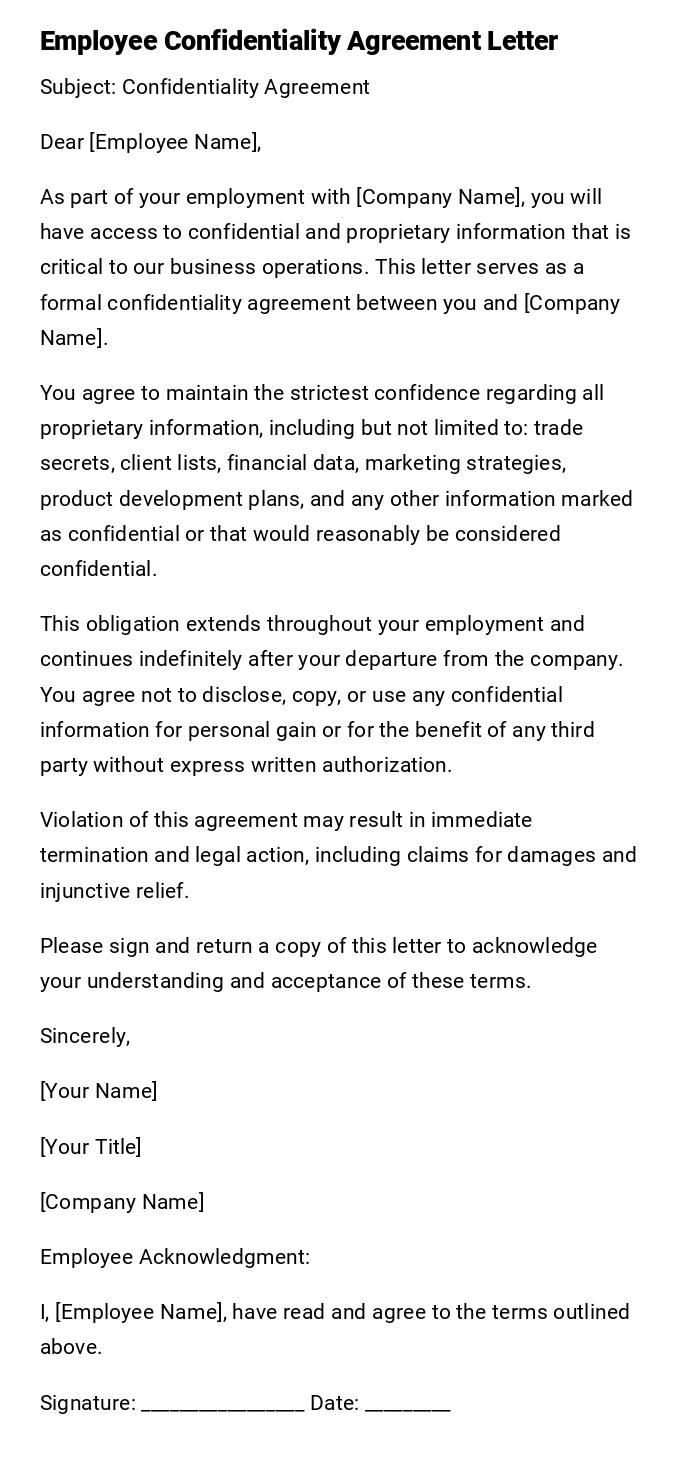
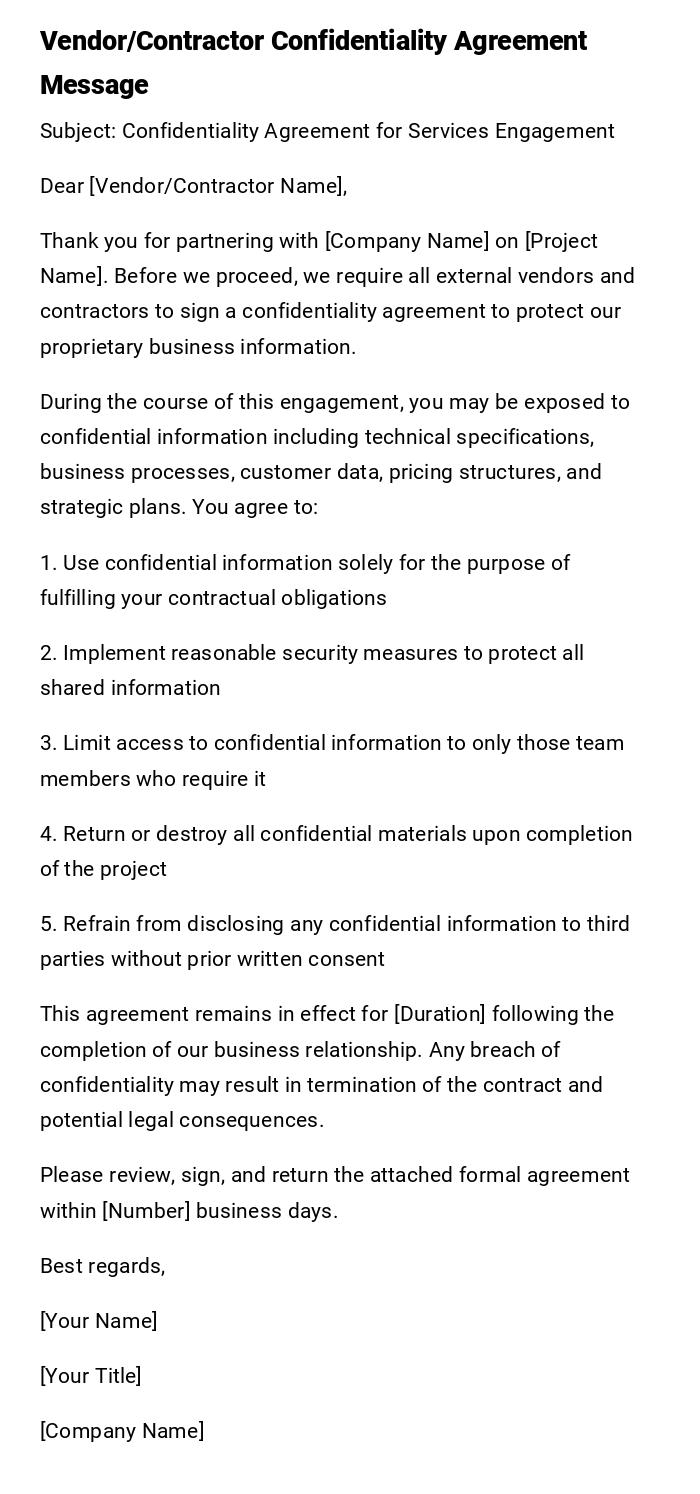
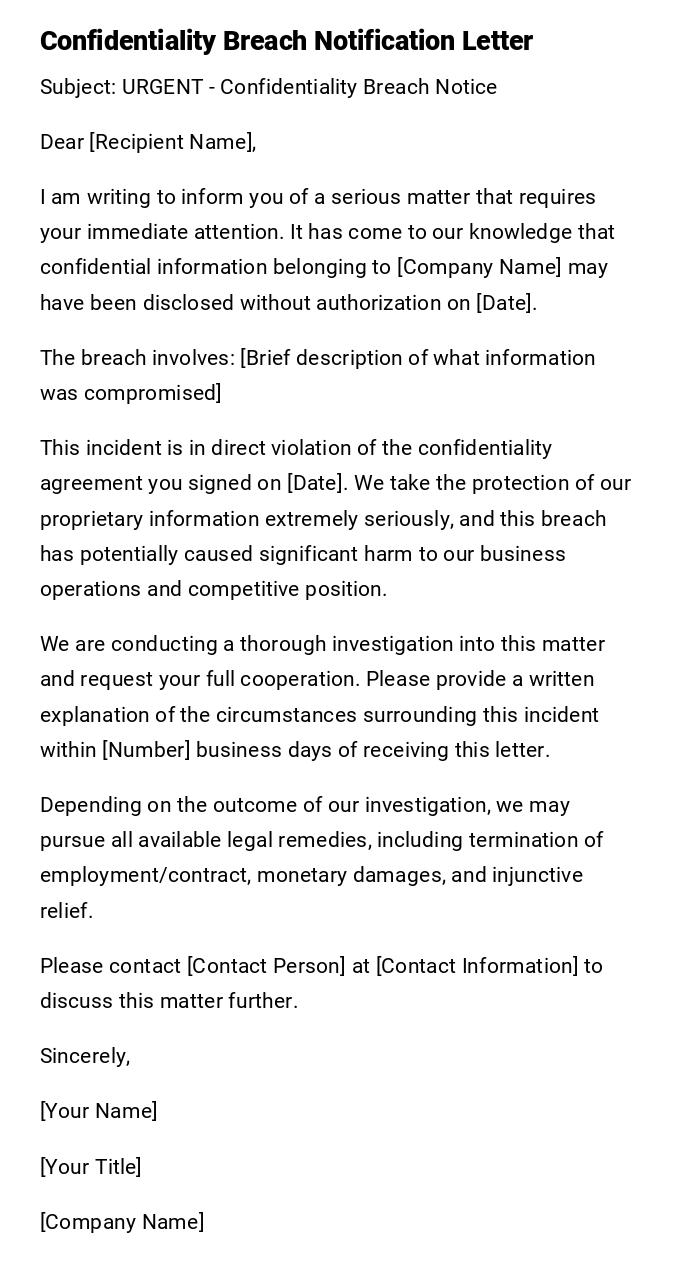
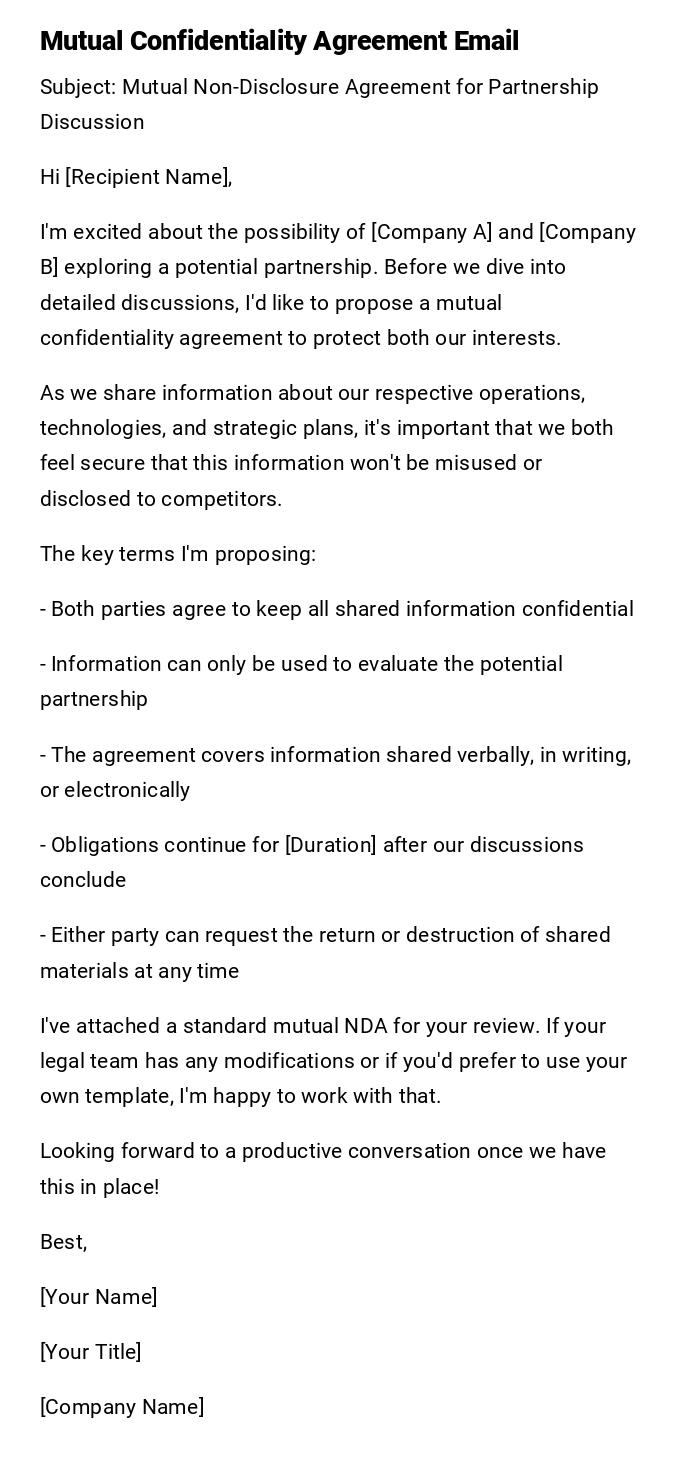
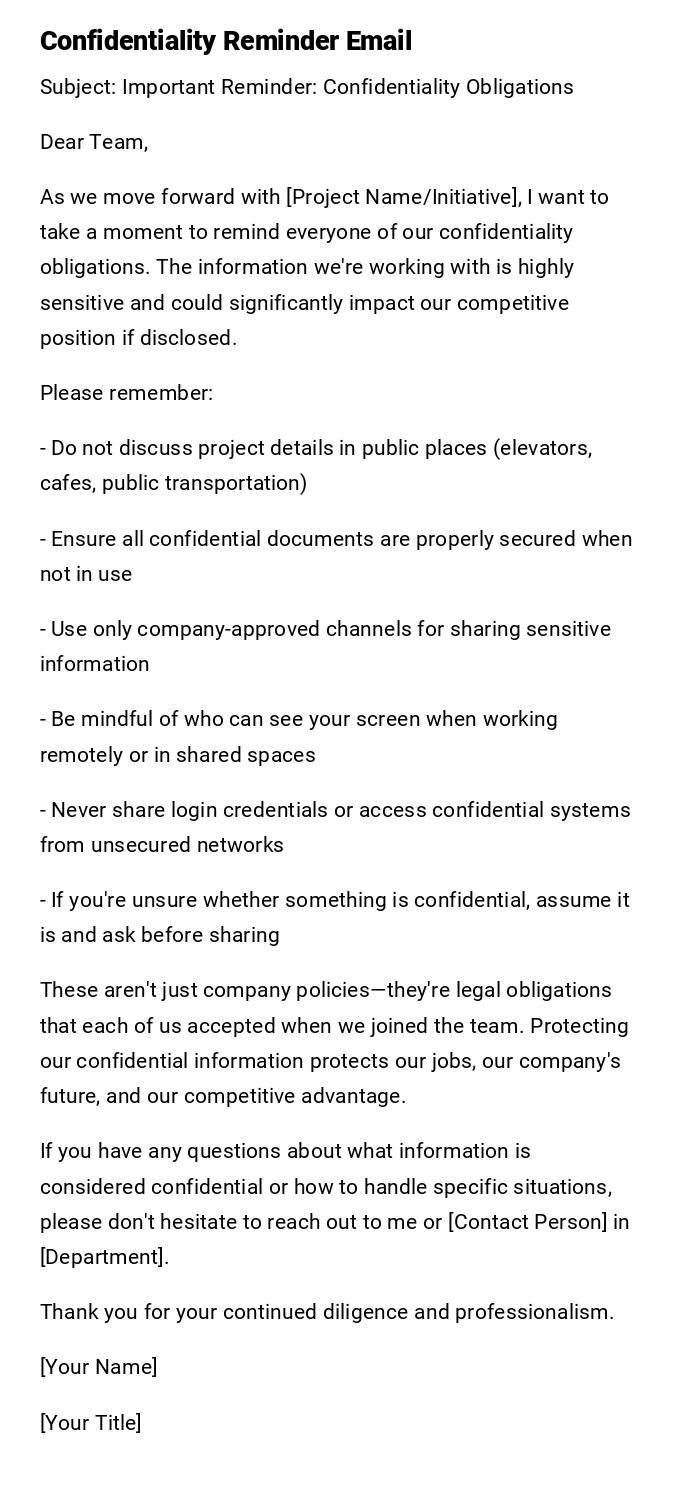
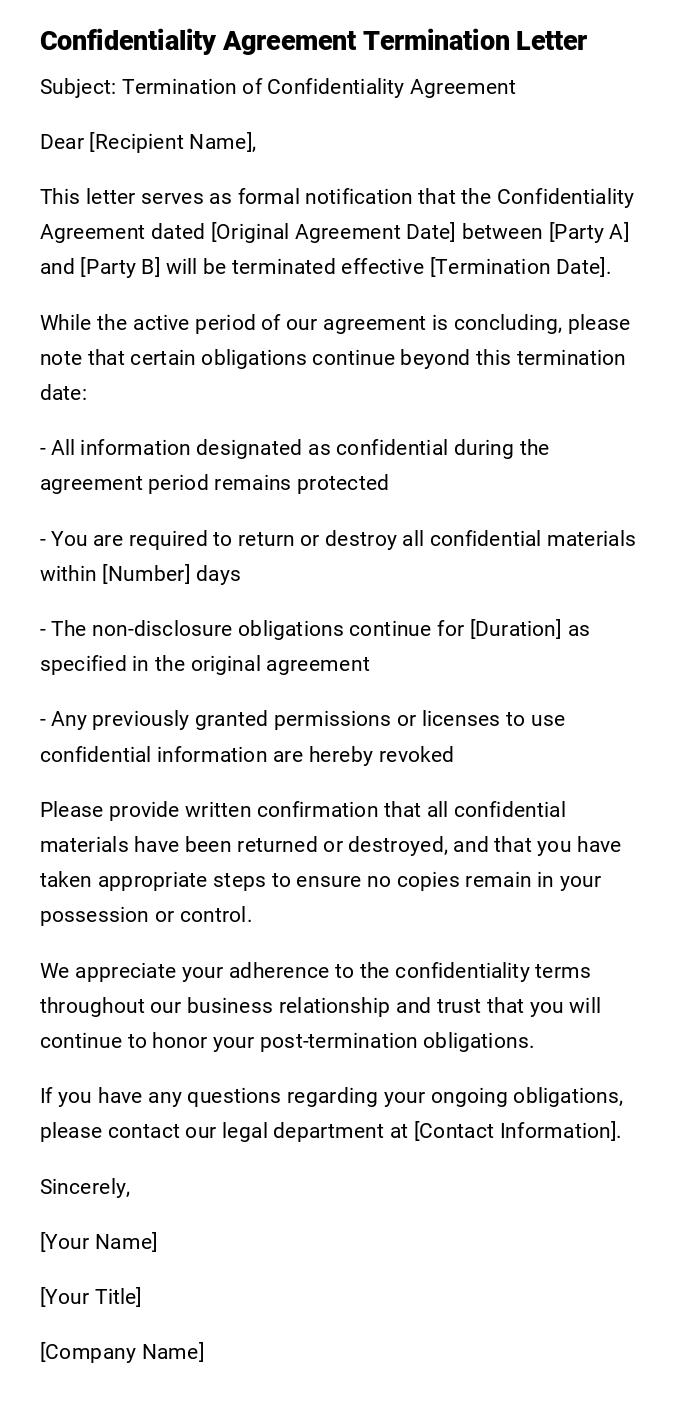
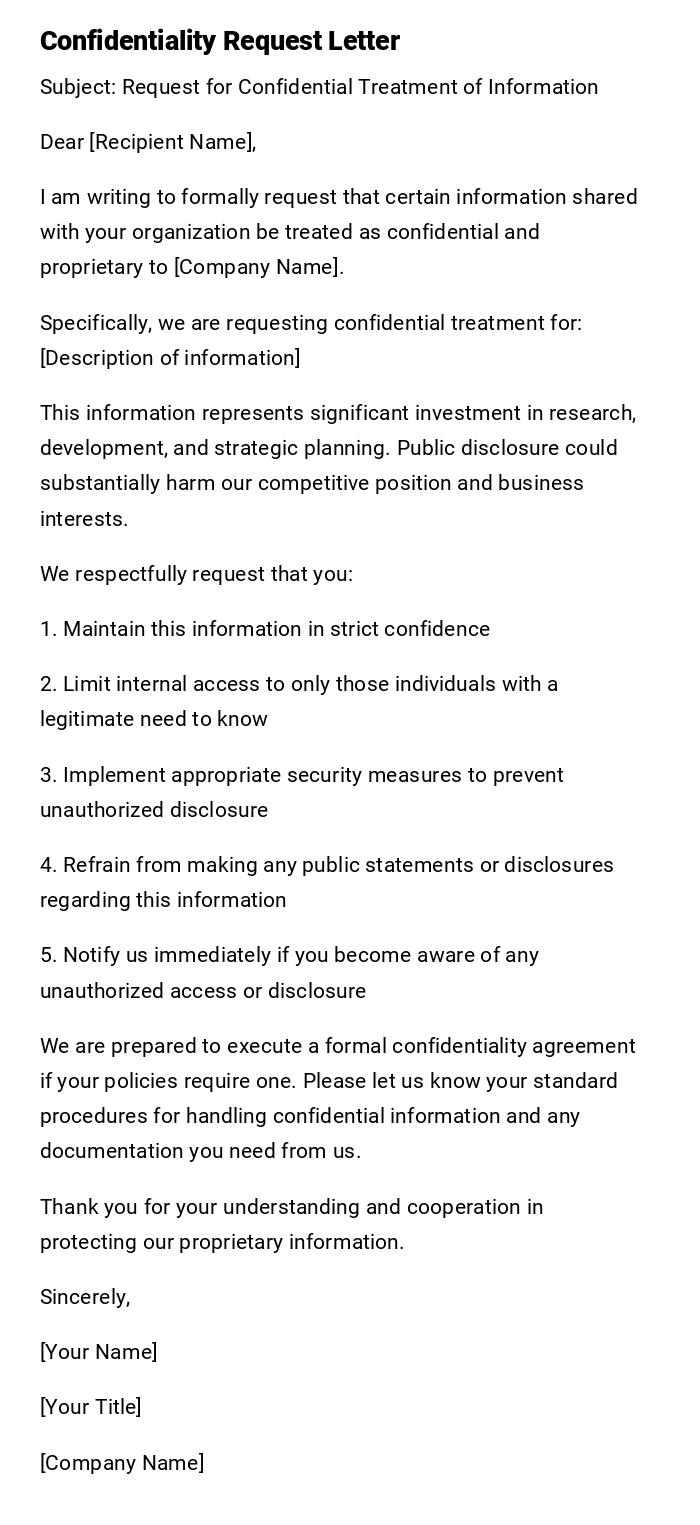
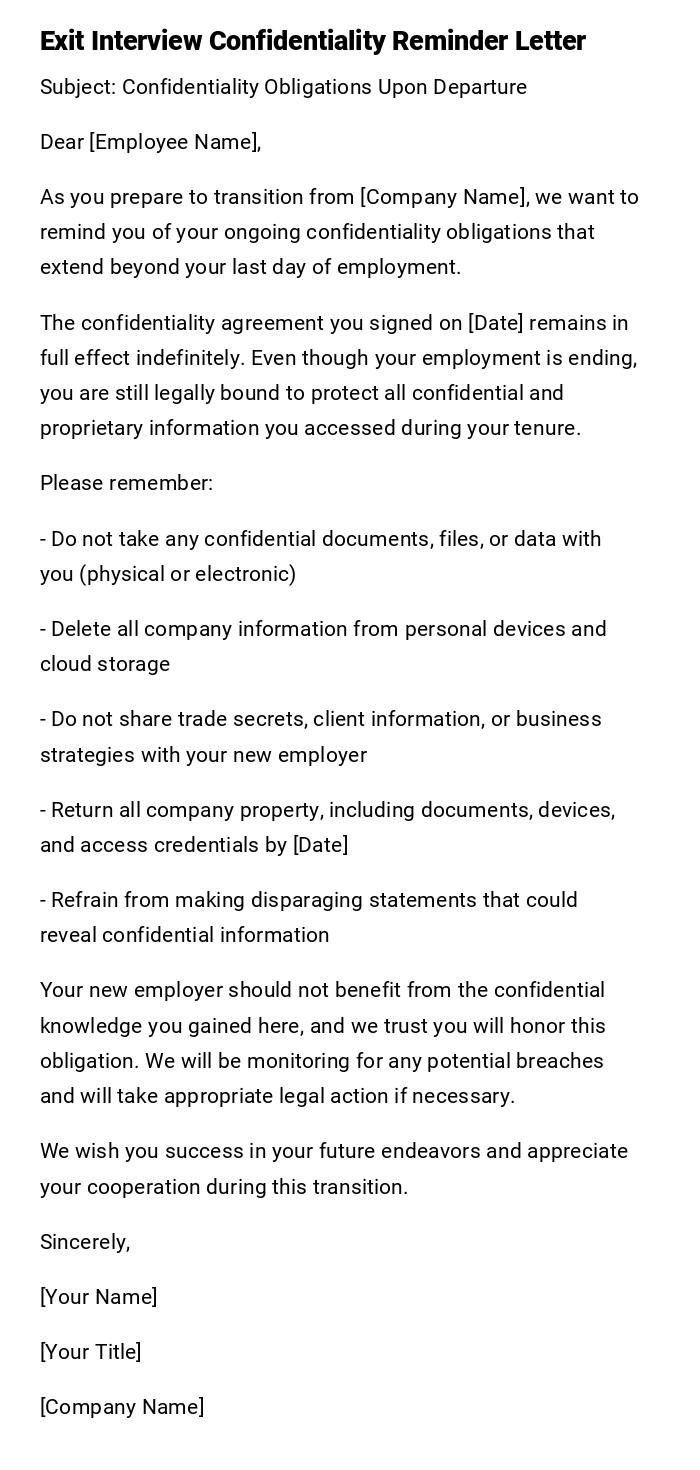

 Download Word Doc
Download Word Doc
 Download PDF
Download PDF